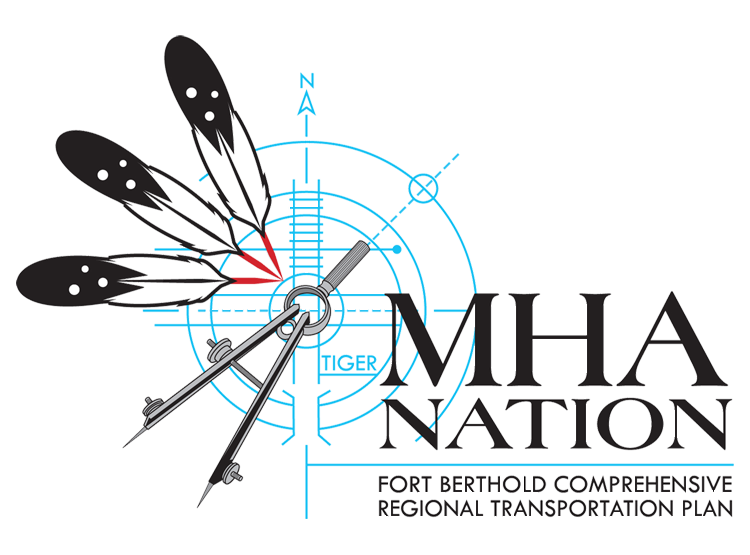BRIDGES
Bridges could be a lifeline for reconnecting Fort Berthold, improving regional connectivity and the economy, and improving access to essential services such as work, emergency response, law enforcement, education, and health care.

Bridge Feasibility Study
What is the Bridge Feasibility Study?
This bridge feasibility study will define the options available to the Three Affiliated Tribes to reconnect the close community and economic ties that existed prior to the construction of the Garrison Dam by constructing up to two bridges. It is important to clarify that this study is a strategic exercise that quantifies the costs, including financial, environmental, landowner and community impacts for the Tribe to re-establish a physical route that connects Twin Buttes Segment with White Shield and Mandaree Segments. This is what was taken from the Tribe when the Garrison Dam was constructed. These construction costs, including the bridges and roads, are important to determine the overall transportation funding needs of the Fort Berthold Indian Reservation when transportation funding allocation formulas are established at a national level. By not establishing the actual locations and costs the Tribe is severely short changing itself in the competitive world of infrastructure financing. Completion of this study is not a decision to move forward to construction. The study will identify sites where bridge structures can be reasonably constructed and evaluate the costs, risks, impacts, and benefits of building bridges such as the Charging Eagle Bay and/or Elbowoods Bridges over strategic points of Lake Sakakawea. Guided by the Technical Advisory Committee, the study team will assess and synthesize in-depth research, reliable data, traffic projections, financial strategies, and community input that will be published in a final report to the Tribal Council. The final report is scheduled to be published in August 2018.
With the construction of the Garrison Dam and Lake Sakakawea in 1956, one-sixth of the Fort Berthold area was flooded (152,360 acres), and 70% of our road and bridge infrastructure was permanently lost. This displaced our families, destroyed sacred sites, ruined the best farmland, flooded valuable natural resources, destroyed the economy, and isolated communities that had previously been physically connected. The Charging Eagle Bay and Elbowoods bridges could help reconnect our communities, as well as create more viable corridors for trucking, recreation, and commercial travel. This would impact Fort Berthold and the whole region! Our goal is to understand, assess, and document the social, cultural, environmental, and economic trade-offs and impacts of these potential projects before we make decisions that would impact Fort Berthold for many generations.
In the early ’70’s, the Army Corps of Engineers conducted an environmental assessment (see document below) for the construction of the Charging Eagle Bay Bridge. At the time, the proposed bridge project was to span 4,500 feet across the Little Missouri River arm of Lake Sakakawea and connect State Highway 22 (near Mandaree) with State Highway 8 (near Twin Buttes). By conducting a feasibility study for the Charging Eagle Bay and Elbowoods bridge development, we can best understand the costs, benefits and investment required to reconnect our communities.
Why?
Access to Vital Services.
Bridges are important for providing Fort Berthold residents access to essential services such as work, emergency responders, education, and health care.
Connect Fort Berthold.
Not only would a bridge help reconnect Fort Berthold, but it would stimulate economic growth and connectivity across the region.
Reduce Travel Time.
The proposed bridges would greatly reduce travel time across the reservation and eliminate the need to drive off of Fort Berthold boundaries.
Reconnect our communities.
By connecting isolated areas of Fort Berthold by bridge, there is greater opportunity to strengthen community relationships and improve our connectivity to the region.

Improve Emergency Response.
The proposed bridges would help reduce the distance and time needed for emergency responders and law enforcement officers to reach all segments of Fort Berthold.

Equity.
In order for MHA Nation to ensure equitable health services, employment opportunities, and access to education with neighboring counties and states, it is essential to invest in a transportation infrastructure system.
How many miles do you have to travel to get from Mandaree to Twin Buttes currently?
How many miles would would you have to travel from Mandaree to Twin Buttes with the proposed Charging Eagle Bay bridge?
How many miles do you have to travel to get from White Shield to Twin Buttes currently?
How many miles would would you have to travel to get from White Shield to Twin Buttes with the proposed Elbowoods bridge?
How many years have our communities been isolated from each other due to the completion of the Garrison Dam?
Source: Google Earth
Technical Memorandum #1
Technical Memorandum #1 introduces the Technical Advisory Committee for the Charging Eagle Bay/Elbowoods Bridge projects, identifies meeting summary and outcomes, and the project goals.
Technical Memorandum #2
Technical Memorandum #2 presents the refinement of the bridge evaluation criterial and priorities, critical success factors, key assumptions, design criteria, and project goals (refined).
Charging Eagle Bay Bridge Environmental Statement (early 1970's)
This document was created in the 1970’s by the Army Corps of Engineers and provides an in-depth look at the environmental impacts of the proposed Charging Eagle Bay Bridge.
What would YOU like to see addressed in the Bridge Feasibility Study?
Enter your full name, a valid email address, and a detailed message in the forms just below to tell us what YOU would like to see addressed in the Bridge Feasibility Study. What else would you like to know about it? Also, we want to hear your stories and perspectives on the questions framing this project; How did we end up with the bridge infrastructure that we currently have? Where are we today? What do we want our communities to look like in 20 years?
Also, be sure to follow our blog, Facebook, Instagram, Twitter, Google+ and Linkedin!




